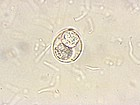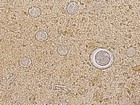Difference between revisions of "Isospora spp."
Fiorecastro (talk | contribs) |
|||
| Line 1: | Line 1: | ||
| − | + | {{OpenPagesTop}} | |
{{Taxobox | {{Taxobox | ||
|name = Isospora spp. | |name = Isospora spp. | ||
| Line 78: | Line 78: | ||
{{review}} | {{review}} | ||
| − | + | {{OpenPages}} | |
| − | |||
[[Category:Intestinal Diseases - Cat]] | [[Category:Intestinal Diseases - Cat]] | ||
Revision as of 17:56, 4 June 2016
| Isospora spp. | |
|---|---|
| Kingdom | Protista |
| Phylum | Apicomplexa |
| Class | Coccidiasina |
| Family | Eimeriidae |
| Genus | Isospora |
| Species | There are many e.g. Isospora suis. |
Introduction
There are many different species of Isospora, all of which are host specific. The most commonly seen of all the Isospora species is Isospora suis in the pig.
Identification
Each oocyst measures 20-50μm. The eggs are subspherical, and the wall is colourless and thin. When sporulated each one contains two sporocyts each with four sporozoites.
Life Cycle
There are essentially three stages in the Isospora life cycle. The first is called sporogony and is the asexual stage of the parasite development. It occurs exogenously, and leads to the development of sporozoites in the oocysts. After this occurs, the oocysts are now deemed infective.
The host ingests the infectious oocyst and the digestive enzymes break down the oocyst wall causing the release of infective sporozoites. The sporozoites then go on to penetrate the intestinal villus epithelium, namely the jejunum and the ileum. Each sporulated oocyst contains 2 sporocysts each with 4 sporozoites. This stage will occur relatively quickly under optimal conditions of high humidity and temperatures between 20 and 400C.
The next step is schizogony. This is an asexual process which occurs endogenously. After the sporozoites invade the epithelia, they then form trophozoites. These trophozoites then form merozoites, which is known as merogony.
Gametogony, which is sexual division occurs endogenously, namely in the intestinal cells. Merozoites then form either microgamonts (male) or macrogamonts (female). Invasion of macrogametocytes containing cells by microgametocytes leads to fertilization, and the cycle continues.
Clinical Signs
Clinical signs are due to destruction of the intestinal epithelium and sometimes the underlying connective tissue of the mucosa.
There may be haemorrhage into the lumen of the intestine, catarrhal inflammation and diarrhoea. There may be dysentry, tenesmus and dehydration. Anaemia is only seen in severely affected animals.
Diagnosis
Sugar or salt flotation methods enable oocysts to be observed in the faeces.
Diarrhoea may precede a heavy output of oocysts, and may continue after the output has finished, therefore multiple faecal samples may be necessary to identify oocysts.
The number of oocysts in a sample can vary and must be related to clinical signs and lesions, and the species observed must be found to be pathogenic to that host. Other causes of diarrhoea should be ruled out before Isospora infection is diagnosed.
Many nonpathogenic species can be found during episodes of diarrhoea, which will not allow a diagnosis of coccidiosis in that species.
Treatment
The life cycle of Isospora is self limiting and infection should resolve spontaneously within a few weeks unless reinfection occurs. Medication can shorten the length of clinical signs and lessen the likelihood of complications and death.
Sick animals should be isolated and treated individually if possible.
Soluble sulfonamides such as sulfaquinoxaline are effective in most species. Amprolium can be used in large animals, and can be given as a preventative treatment to healthy in contact animals.
Isospora in Cats and Dogs
Isospora species in cats are I. felis and I. rivolta which can be identified by size and shape. Four species infect the dog: I. canis, I. ohioensis, I. burrowsi and I. neorivolta.
Clinical illness is uncommon but heavy infections have been reported in kittens and puppies. In kittens, infection is usually seen at weaning.
Clinical signs include: bloody diarrhoea, weight loss and dehydration.
The illness can be associated with other infections and immunosuppression.
Cats usually spontaneously eliminate the infection, but if they are clinically ill, trimethoprim-sulfa can be given.
| Isospora spp. Learning Resources | |
|---|---|
To reach the Vetstream content, please select |
Canis, Felis, Lapis or Equis |
 Test your knowledge using flashcard type questions |
Coccidia Flashcards |
 Search for recent publications via CAB Abstract (CABI log in required) |
Isospora spp. publications |
References
Bowman, D. (2002) Feline Clinical Parasitology Wiley-Blackwell
Merck and Co (2008) Merck Veterinary Manual Merial
| This article has been peer reviewed but is awaiting expert review. If you would like to help with this, please see more information about expert reviewing. |
Error in widget FBRecommend: unable to write file /var/www/wikivet.net/extensions/Widgets/compiled_templates/wrt677fb418e29f00_20901869 Error in widget google+: unable to write file /var/www/wikivet.net/extensions/Widgets/compiled_templates/wrt677fb418e7e9f3_28431038 Error in widget TwitterTweet: unable to write file /var/www/wikivet.net/extensions/Widgets/compiled_templates/wrt677fb418ed1424_34828339
|
| WikiVet® Introduction - Help WikiVet - Report a Problem |

